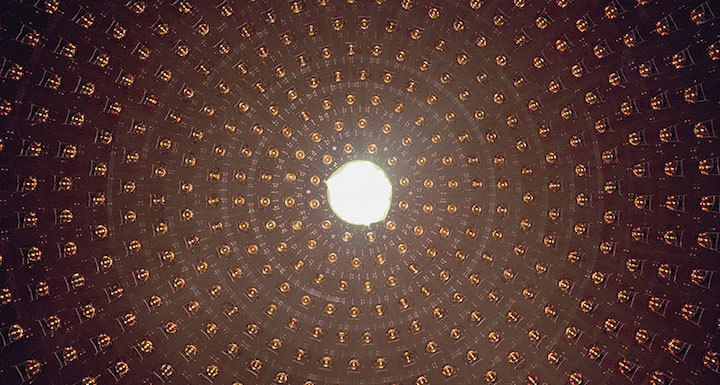3.06.2018

Pip-squeak particles called neutrinos are dishing out more than scientists had bargained for.
A particle detector has spotted a puzzling abundance of the lightweight subatomic particles and their antimatter partners, antineutrinos, physicists report May 30 at arXiv.org. The finding mirrors a neutrino excess found more than two decades ago. And that match has researchers wondering if a new type of particle called a sterile neutrino — one even more shadowy than the famously elusive ordinary neutrinos — might be at large.
Such a particle, if it exists, would transform the foundations of particle physics and could help solve cosmic puzzles like the existence of dark matter, an unidentified inert substance that makes up the preponderance of the matter in the universe.
The new study was conducted with a neutrino detector called MiniBooNE, while the previous neutrino excess was found with a different apparatus, the Liquid Scintillator Neutrino Detector, which operated in the 1990s at Los Alamos National Laboratory in New Mexico. “We have two very different detectors … and we have the same results,” says MiniBooNE physicist En-Chuan Huang of Los Alamos National Laboratory.
Hints of excess neutrinos have shown up in earlier results from MiniBooNE, which has been operating since 2002 at Fermilab in Batavia, Ill. But the new research includes twice as much data, making the neutrino deluge too strong to ignore.

Still, some physicists are questioning whether the excess signals are really from neutrinos. “The events … are real. The question is, what are they?” says neutrino physicist Jonathan Link of Virginia Tech in Blacksburg. The apparent neutrino surplus could be a red herring: Other particles can interact in ways that mimic neutrinos.
Neutrinos come in three known types: electron neutrinos, muon neutrinos and tau neutrinos, named after the electron and its two heavier cousins, muons and taus. Weirdly, neutrinos can morph from one type to another: A particle born as a muon neutrino might later be detected as an electron neutrino (SN: 1/26/13, p. 18).
In the new experiment, scientists blasted muon neutrinos and antineutrinos at MiniBooNE, and looked for particles that had morphed into the electron type. Using a large tank of mineral oil outfitted with sensitive light detectors, MiniBooNE looked for small flashes of light produced in electron neutrino and antineutrino interactions. The researchers saw 2,437 interactions, about 460 more than predicted.
That excess potentially hints at the existence of sterile neutrinos, which could alter the way neutrinos shift from one type to another, causing more muon neutrinos to morph into the electron type than otherwise expected. While ordinary neutrinos rarely interact with matter, sterile neutrinos wouldn’t interact at all, except via gravity.
Sterile neutrinos have been proposed as a possible candidate for what makes up dark matter. But to explain the MiniBooNE results, the sterile neutrinos would have to be relatively lightweight — too puny to explain dark matter. Still, the existence of light sterile neutrinos might suggest heavier ones are out there, too, says cosmologist Kevork Abazajian of the University of California, Irvine. “Sometimes people say they're like cockroaches: If you have one [type of] sterile neutrino, you have many.
Other neutrino misbehavior has shown up in experiments that measure electron antineutrinos produced in nuclear reactors. These experiments see fewer interactions than expected, a result that could also be explained by a sterile neutrino (SN: 3/19/16, p. 14). But there’s an inconsistency: A sterile neutrino should cause a deficit of muon neutrinos in other experiments, but that hasn’t been seen. That means the explanation is likely more complicated than there being a single type of sterile neutrino.
It’s not yet clear how the various results from different neutrino experiments fit together. For now, the new study has physicists puzzled. “I actually don’t know what to make of it,” says neutrino physicist Kate Scholberg of Duke University. But theoretical physicists, she says, “will chew on this like crazy.”
Quelle: Science News
